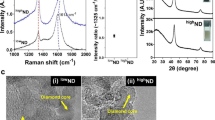A morphological analysis of the liver of Wistar rats was performed 2 months after a single intravenous injection of porous silicon particles of different sizes (60-80, 250-300, and 500-600 nm; 2 mg/ml, 1 ml). Histological, immunohistochemical, and electron microscopic methods showed the development of CD68+ granulomas in all experimental groups. Injection of 60-80-nm porous silicon particles led to the formation of single large granulomas (>2000 μm2), while 500-600-nm nanoparticles caused the formation of numerous smaller granulomas. The mechanism of involution of granulomas by apoptosis of Kupffer cells and the absence of subsequent connective tissue remodeling of the organ tissue is shown.
Similar content being viewed by others
References
Braakhuis HM, Park MV, Gosens I, De Jong WH, Cassee FR. Physicochemical characteristics of nanomaterials that affect pulmonary inflammation. Part. Fibre Toxicol. 2014;11:18. https://doi.org/10.1186/1743-8977-11-18
Ghaffarian R, Muro S. Models and methods to evaluate transport of drug delivery systems across cellular barriers. J. Vis. Exp. 2013;80:e50638. https://doi.org/10.3791/50638
Roy S, Glueckert R, Johnston AH, Perrier T, Bitsche M, Newman TA, Saulnier P, Schrott-Fischer A. Strategies for drug delivery to the human inner ear by multifunctional nanoparticles. Nanomedicine (Lond). 2012;7(1):55-63. https://doi.org/10.2217/nnm.11.84
Osminkina LA, Kudryavtsev AA, Zinovyev SV, Sviridov AP, Kargina YV, Tamarov KP, Nikiforov VN, Ivanov AV, Vasilyev AN, Timoshenko VY. Silicon nanoparticles as amplifiers of the ultrasonic effect in sonodynamic therapy. Bull. Exp. Biol. Med. 2016;161(2):296-269. https://doi.org/10.1007/s10517-016-3399-x
Konoplyannikov MA, Eremina AS, Kargina YuV, Le Deygen IM, Kharin AYu, Bazylenko TYu, Yusubalieva GM, Revkova VA, Matchuk ON, Zamulaeva IA, Abramova MR, Kotova SL, Timashev PS, Baklaushev VP, Timoshenko VYu. Mesoporous silicon nanoparticles loaded with salinomycin for cancer therapy applications. Microporous and Mesoporous Materials. 2021;328:111473. https://doi.org/10.1016/j.micromeso.2021.111473
Ivanov S, Zhuravsky S, Korolev D, Galagudza M, Yukina G. In vivo toxicity of intravenously administered silica and silicon nanoparticles. Materials. 2012;5:1873-1889. https://doi.org/10.3390/ma5101873
Rosenholm JM, Mamaeva V, Sahlgren C, Lindén M. Nanoparticles in targeted cancer therapy: mesoporous silica nanoparticles entering preclinical development stage. Nanomedicine (Lond). 2012;7(1):111-120. https://doi.org/10.2217/nnm.11.166
Sviridov AP, Osminkina LA, Kharin AY, Gongalsky MB, Kargina JV, Kudryavtsev AA, Bezsudnova YI, Perova TS, Geloen A, Lysenko V, Timoshenko VY. Cytotoxicity control of silicon nanoparticles by biopolymer coating and ultrasound irradiation for cancer theranostic applications. Nanotechnology. 2017;28(10):105102. https://doi.org/10.1088/1361-6528/aa5b7c
Yukina GYu, Sukhorukova EG, Polovnikov IV, Kryzhanovskaya EA. Effect of silicon dioxide nanoparticles on liver morphology of rats in parenteral administration. Zh. Anat. Gistopatol. 2021;10(4):85-88. Russian. https://doi.org/10.18499/2225-7357-2021-10-4-85-88
Spivak YM, Belorus AO, Moshnikov VA, Bespalova K, Somov PA, Panevin AA, Zhuravskii SG, Zhukov YM, Komolov AS, Chistyakova LV, Grigor’eva NY. Porous silicon as a nanomaterial for disperse transport systems of targeted drug delivery to the inner ear. Tech. Physics. 2018;63(9):1352-1360. https://doi.org/10.1134/S1063784218090207
Basit H, Tan ML, Webster DR. Histology, Kupffer Cell. StatPearls [Internet]. Treasure Island (FL): StatPearls Publishing; 2023.
Croissant JG, Brinker CJ. Biodegradable silica-based nanoparticles: dissolution kinetics and selective bond cleavage. Enzymes. 2018;43:181-214. https://doi.org/10.1016/bs.enz.2018.07.008
Author information
Authors and Affiliations
Corresponding author
Additional information
Translated from Byulleten’ Eksperimental’noi Biologii i Meditsiny, Vol. 176, No. 9, pp. 386-390, September, 2023
Rights and permissions
Springer Nature or its licensor (e.g. a society or other partner) holds exclusive rights to this article under a publishing agreement with the author(s) or other rightsholder(s); author self-archiving of the accepted manuscript version of this article is solely governed by the terms of such publishing agreement and applicable law.
About this article
Cite this article
Zhuravskii, S.G., Yukina, G.Y., Sukhorukova, E.G. et al. The Pattern of Granuloma Formation in the Liver of Rats as a Reflection of the Mechanism of Internalization of Submicron Silicon Particles. Bull Exp Biol Med 176, 399–402 (2024). https://doi.org/10.1007/s10517-024-06032-z
Received:
Published:
Issue Date:
DOI: https://doi.org/10.1007/s10517-024-06032-z



